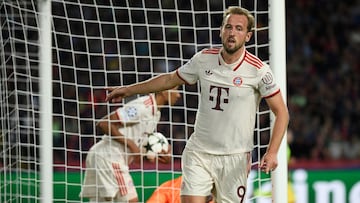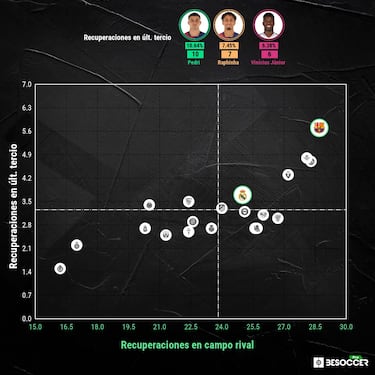Has Harry Kane handed Real Madrid the clues to beating Barcelona ahead of El Clásico?
The Bayern Munich striker explained Vincent Kompany’s game plan and highlighted an area to exploit.

In Carlo Ancelotti’s office, preparations are underway for El Clásico, and it’s certain that the Italian coach, along with Davide and Mauri, paid close attention to Barcelona’s 4-1 win over Bayern Munich. Although Bayern seemed like a feared opponent and it was expected to be a serious challenge for the Blaugranas, they ultimately became a public sparring partner from which Madrid can draw useful conclusions ahead of Saturday’s huge clash. Harry Kane, who scored Bayern’s only goal and saw another ruled out by the semi-automatic offside system, revealed Bayern’s attacking plan in the mixed zone. It was a plan with good intent but poor execution. “Barça’s high press gave us opportunities, but we didn’t exploit them and they punished us on the transitions,” Kane explained, highlighting a key point for the upcoming Clásico this Saturday.
The Englishman also criticised his team for their poor execution of Kompany’s strategy. “I think we had a good moment and then we lost our way a bit, trying for the final pass too quickly. I think if we had had more control of the game, more possession, spaces would have opened up to create more chances. I think we were a bit too rushed trying to play passes behind them,” he added.
Speaking about Bayern, the forward left one of the key insights for the upcoming Clásico: Barcelona’s intense pressing, the space they leave behind, and how Real Madrid could exploit it—but also how they will likely suffer from it.
How Real Madrid can attack Flick’s Barcelona
Hansi Flick’s team’s pressing is one of their main weapons. The German coach has changed the team’s tempo, setting up a 4-2-3-1 and driving the team forward at a rock—or perhaps punk—rhythm. This is an aggressive Barça that chases, runs, “bites,” and strikes. They drag you into a mosh pit where you have to learn how to move. You can get knocked around, but you can also find your way out.

Barcelona’s aggressive pressing, as shown in the diagram above, plays on the edge by relying on an offside trap, leaving a lot of space behind their backline. Harry Kane highlighted this, and Real Madrid has the tools to exploit it—but they could also suffer from it.
Vinícius has been Carlo Ancelotti’s main weapon for attacking Barcelona in recent seasons. The Brazilian brings directness and is the most sought-after player when launching counterattacks. His one-on-one ability, speed in transition, and finishing will once again force Barcelona to pay close attention to the number 7. His run against Dortmund is the perfect example, and his hat-trick in the Champions League shows he’s hitting his stride after a more uncertain start to the season.
In addition, Ancelotti now has Kylian Mbappé to add to this task. The Frenchman will operate centrally and is expected to be the main threat in transitions alongside Vini Jr in his first Clásico. The Franco-Brazilian partnership, however, could easily switch roles: one setting up the play, the other finishing, or vice versa. Together, they’ve tallied 16 goals, eight apiece.

Mbappé and Vinicius: Barcelona’s defensive set-up
Barcelona will be without their ultimate ‘Anti-Vini’, Ronald Araujo, but they have the advantage of Jules Koundé, who is in excellent form as a full-back. He will be tasked with stopping Vinícius. To handle Mbappé, it will likely be Cubarsí and Iñigo Martínez in the heart of the defense. One of the key aspects of the match will be their ability to play the offside trap against Real Madrid’s attackers.
Real Madrid has two additional ‘X-factors’ in attack with Valverde and Jude Bellingham as late runners (Fermín for Barça), but they are currently experiencing problems in their build-up play. Barcelona has already sensed this weakness and will look to ‘trap’ their prey. If Madrid wants to exploit the space behind Barcelona, they will need to resolve this issue by finding a new pivot for their play following Toni Kroos’ departure. Ancelotti tried a three-centre-back solution at Balaídos, but it didn’t work. Now, for the Bernabéu, they are searching for a playmaker to lead their transitions.
Another key point is intensity.
In the first half against Dortmund, Madrid started without energy, and although they defended compactly in a low block, they lacked tension in duels and pressing. A change in attitude – following an ‘Ancelottina’ – completely transformed the game. Madrid will need to solve their ongoing issues with possession and accept that they will suffer until they overcome the high pressure Flick’s teams subject their opponents to.
Defensive support will also be crucial for Real Madrid. They need to contain the most in-form attacking trio in La Liga: Robert Lewandowski, Lamine Yamal, and Raphinha. Bellingham and Valverde, who may line up on the flanks in Madrid’s 4-4-2, will have to work hard to stifle Barcelona’s attack.
Related stories
Opposite them, Mendy and Lucas Vázquez are expected to play as full-backs, with Rüdiger and Militão at centre-back. The absence of Carvajal, last season’s most in-form full-back, undoubtedly weakens Madrid’s defensive strength.

Kane revealed a game plan that, as he himself admitted, they were not accustomed to executing, and where impatience got the better of them. El Clásico, for both Barcelona and Real Madrid, will be decided by the balance between maintaining control and knowing when to break free. Exactly what a Saturday night demands.
Complete your personal details to comment